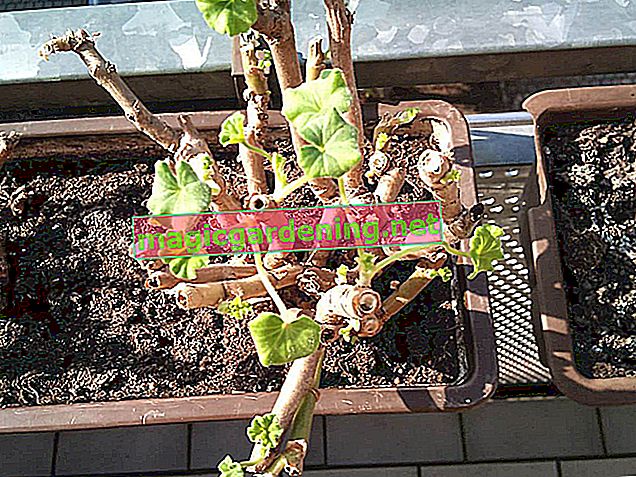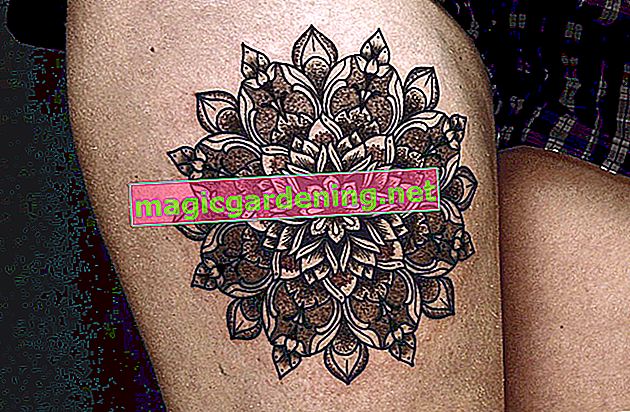
The flow of juice dictates the time of cutting
The growth of spherical maple is characterized by a strong flow of sap . After small and large wounds, the tree literally bleeds to death. With its juices, 'Globosum' loses a large part of its defenses against pathogenic germs. This characteristic largely determines the best date for maintaining the cut.
also read
- Skilfully cutting spherical maple into shape - tips for topiary cutting
- Cutting roots on the spherical maple - is that possible?
- How does a spherical maple grow? - data on growth
In early autumn, sap pressure drops to the lowest level of the year. The weeks between the end of September and the end of October have turned out to be ideal for pruning spherical maples. At the same time, the Federal Nature Conservation Act allows pruning of all kinds of trees from September 30th , so that you can act in accordance with the law by choosing a date.
To determine the perfect day for a cut, one is test cut digestion. Cut back two thin shoots no more than a finger thick and pay attention to the flow of sap. Little bleeding gives the green light for the planned cutting measure. A strong flow of sap suggests postponing the time by a week and performing the test cut again.
Why cut ball maple? - Overview of cutting types
The round crown forms a spherical maple on its own, because it is the result of expert breeding and skillful refinement. Over the years, the spherical shape is lost and tends to a flat-oval crown structure, which is disapprovingly referred to as the "pancake crown". With a regular shape cut, you can prevent unwanted changes. Storm damage is a frequent reason for cutting measures. When Acer platanoides 'Globosum' has shed its leaves in autumn, the bare branches are ideal areas for strong winds to attack. If a spherical maple has not been given pruning care for many years, the crown will noticeably age. A radical taper cut fixes the problem. The following table summarizes important types of cuts:
| Cut type | Goal / occasion |
|---|---|
| Topiary | Keep the crown small and spherical |
| Clearance cut | Remove dead wood, encourage light-flooded growth |
| Repair cut | Fix storm damage |
| Taper cut | rejuvenate aged, misshapen crown |
Cut the crown regularly - topiary cutting instructions
A spherical maple only retains its spherical crown when it is young. Under the influence of a growth rate of 20 to 40 centimeters per year, the spherical crown flattens out noticeably. A crown diameter of up to 6 meters causes space problems in the small garden after a few years. You can effectively counteract unwanted growth with an annual shape cut . This also has the advantage that the cut is limited to thin shoots in the outer crown area. How to master a topiary with flying colors:
- The best time is between the end of September and the end of October (end of January at the latest)
- Carry out a test cut to determine the strength of the juice flow
- You can either cut back all shoots by a third or shorten branches protruding from the shape
- Position the pruning shears at a slight angle 5 millimeters above an outward-facing pair of buds
Thanks to a moderate cut and smart choice of dates, you avoid the dreaded flow of juice. Limit the circumference of the cut to shoots the size of a thumb. This reduces stress for maple trees and gardeners alike. In the meantime, take a few steps back to examine the previous cutting profile and plan the next steps.
background
Genetic mutation overrides the law of growth
The round crown of a spherical maple is the result of a combination of breeding, refinement and genetic mutation. Wild species thrive with a highly oval to pyramidal crown, because this is where the growth law of peak funding rules. As a result, the sprouting on the top buds dominates disproportionately compared to the growth on the buds below. In an Acer platanoides 'Globosum', terminal buds and side buds sprout almost equally. As a result, a spherical crown initially forms, which takes on a broad, oval shape with age. Furthermore, without a dominance of the top buds, the tree cannot form a straight trunk. Because of this, the spherical crown is grafted onto the trunk of a suitable game species.Clearance cut prevents aging
A slimmed-down form of pruning takes place at intervals of 2 to 3 years. The clearing cut focuses on the removal of dead wood and optimizes the crown shape on this occasion. This type of cut is recommended if there is no lack of space or a broad, oval crown shape is desired so that your spherical maple acts as a decorative shade provider at the seat. The goal is a light-flooded spherical crown , which also has dense leaves deep inside. As the illustration below illustrates, it is advantageous if you dedicate yourself to long branches with a skilful derivation cut. How to complete the perfect clearing cut:
- The ideal time window is open from the end of September to the end of October
- Cut on a frost-free day by the end of January at the latest
- Saw off dead, bare branches on astring without leaving long stubs
- Remove shoots that grow transversely or that are directed towards the interior of the crown
- Long branches hanging from the spherical crown or vertically protruding branches lead to a favorable side shoot
- Alternatively, cut back the entire crown by a third or a quarter
The cutting technique of the derivation is advantageous for a round to oval crown shape. The branch in question is not simply pruned back to a pair of buds because it creates a gap. Find a strong, outward-pointing branch near the planned intersection. Use pruning shears or a saw where old and young branches fork.

Wild shoots from trunk and tree disc - what to do?
Below a spherical crown, the game pad draws attention to itself with wildly growing shoots. The branches sprout from the trunk and tree disc, endowed with robust vigor. The wild shoots, known as water shoots or blind shoots, cheekily strive to overgrow the noble crown. With this strategy they want to win the competition for nutrients, water and light. In this dispute, your spherical maple depends on the help of horticulturists, because it cannot defend itself against the vital onslaught. How to act correctly:
- Remove every game shoot promptly
- Alternatively, grasp the water shot with your hand and break it off to the side or downwards
- Tear off blind shoots from the tree disc with a brave jerk
If a game shoot has cheated its way through for more than a year, you can usually no longer break or tear it off. The resulting wound on the trunk bark would be fatal and a welcome target for fungal pathogens and pests. In this case, cut off the wildling, smooth the wound with a knife and sprinkle stone meal or charcoal ash over it.
Repair storm damage to the spherical maple
An empty spherical maple has little to oppose autumn and winter storms. Without the large maple leaves as a buffer zone, the branches offer unprotected starting points for strong gusts of wind and break. Storm damage is no reason for clearing. With a strategically ingenious repair cut, you can bring the growth back into balance. How to proceed professionally:
- Cut back damaged branches into healthy wood
- Always make a cut a short distance from a pair of buds
- Saw off completely destroyed shoots on astring
- Cut back the remaining branches so that the round crown shape is restored
Do you feel compelled to prune noticeably thick branches? Then your ball maple will sprout vigorously at this point. In the following early autumn cut out excess branches from the crown. Ideally, thin out heavily branched crown areas by diverting weak shoots to a stronger one. Experience shows that it takes a few years for your damaged spherical maple to present itself in its old glory.
Tips
Never cut into the finishing point. A spherical maple consists of a straight trunk and a noble crown without a dominant trunk extension. The neuralgic point is the connection between game base and precious part. If the processing agency suffers wounds or is completely cut off, the game underlay drifts through. You will then look in vain for the picturesque spherical crown. At least the head with the stubby branches must withstand a cut back so that the grafting area remains intact.
Revitalize the aging spherical crown - rejuvenation cut
Neglected pruning, extreme pest infestation or massive fungal infections are classic occasions for a rejuvenation cut on the spherical maple. How to properly revitalize an aged or sick spherical crown:
- The best time is between the end of September and the end of January
- Cut back all branches except for stumps that are 10 to 15 centimeters long
- Caution: do not cut into the little head-shaped finishing point
It is not mandatory that you do the radical cut in a single day. The procedure is gentler and more tolerable if you spread the rejuvenation over several dates between the end of September and the end of January. This gives the troubled spherical maple the opportunity to regenerate and gather strength between the stages of cutting.
Digression
The right cutting tool for all branch sizes
The combination of cutting sensitivity and strong juice flow requires the right cutting tools. Smooth cuts guarantee that sap drains off quickly. For shoots up to 3.5 centimeters thick, therefore, we recommend loppers with a bypass mechanism. Here two sharp edges run past each other. In the case of anvil shears, a sharp cutting edge first presses the shoot against the blunt anvil, which can lead to crushing. Branches with a diameter of 4 centimeters and more are a case for the Japanese saw, also known as a folding saw. It is important to note that the scissor blades and saw blades are meticulously clean. Thoroughly disinfect the tool with spirit or glass cleaner before you start cutting. Youtubefrequently asked Questions
Our house is about 6 meters away from the neighboring house. Most of the lines run there. Is this distance sufficient for the roots of a spherical maple? Can the roots cause damage to the pipes?
The distance of 6 meters between the two houses is close, but should be enough. An occasional shape cut keeps the expansion of the crown of a spherical maple in check. As shallow roots, the risk of line damage is low, but it cannot be completely ruled out. It largely depends on how well the cables are insulated and how deep they run into the ground. The soil conditions are also relevant. In heavy, moist loam soil, the roots of the spherical maple grow less deep than in loose, sandy, dry soil.
Today we received a ball maple in a pot. In our small garden, the treetop must not become too voluminous. When and how often is pruning advisable?
A plant cut is not required on the spherical maple. The tree forms its spherical crown even without a topiary. To keep the spherical crown small, you can shorten the shoots by a third or a quarter every year. The best time is in late autumn after the leaves have fallen. Maple trees pruned in spring bleed relatively heavily, which can weaken the trees. If, on the other hand, the loppers are used between September and January, a spherical maple bleeds minimally or not at all.
I would like to line my driveway with spherical maple. Is the trunk still growing in height or does it remain at the height that was delivered?
The trunk height of the globe maple 'Globosum' no longer changes. Only the crown grows in height and width. In the course of the years between 300 and 600 centimeters are reached. By trimming back regularly, you can keep the crown shape smaller.
A spherical maple in our garden is 4 to 5 meters high. We can no longer walk upright under his crown. For this reason we want to cut back the tree. When is the best time? Will he then drive out again?
The best date for pruning is in late autumn. During the months of September to January, a spherical maple hardly bleeds and is only slightly susceptible to red pustules. On larger cuts, please coat the wound edges thinly with tree wax (€ 5.99 at Amazon *) to protect the sensitive wound wood from frost. An Acer platanoides 'Globosum' can easily cope with pruning by half or two thirds and will sprout again next spring.
I planted my new spherical maple in the spring. It is well grown and has a lush, leafy crown. Now in October I noticed that white powdery mildew was spreading on the foliage. What can I do against it?
Maple trees are unfortunately prone to powdery mildew in summer. Under the influence of warm and humid weather, the fungal spores prefer to nest on the large leaves. It is not necessary to counteract this with fungicides in autumn. Wait for the leaves to fall and collect all the leaves to dispose of with general waste. If you provide the ball maple with sufficient fertilizer from April to the end of June in the coming spring, it will sprout healthy leaves. With increasing age, the susceptibility to powdery mildew decreases significantly.
Can I use the clippings as cuttings to grow a new spherical maple?
Unfortunately that is not possible. Ball maple is the refined form of the Norway maple (Acer platanoides). The spherical crown is the result of a head refinement by the hand of the gardener. Against this background, the relatively high prices for a young plant are understandable.
The 3 most common mistakes
A misshapen, prematurely aged crown is the victim of typical errors in the pruning of spherical maple. If the crown does not sprout after a cut or if it emerges as unsightly undergrowth, there is also a classic flaw behind it. To save you from such annoyances, the following table lists the three most common cutting mistakes by name and gives tips for preventive measures:
| Cutting errors | Damage | prevention |
|---|---|---|
| never exposed | aged crown, which is balding from the inside | Remove dead wood every 2 to 3 years |
| cut into the finishing point | Game pad drifts through, no more spherical crown | do not cut into the finishing point |
| cut in spring | strong sap flow, sticky tree, increased infestation with diseases and pests | cut from the end of September |
Tips
Are you concerned that the long, flat roots of ball maple will lift up patio and path slabs? Then plant the tree with a root barrier. Line the planting pit 70 to 80 centimeters deep with impenetrable geotextile. (€ 84.99 at Amazon *) So that the roots do not grow over the barrier, it should protrude about 10 centimeters from the earth.








